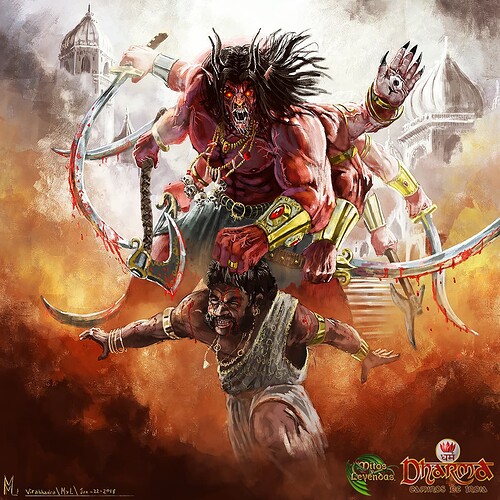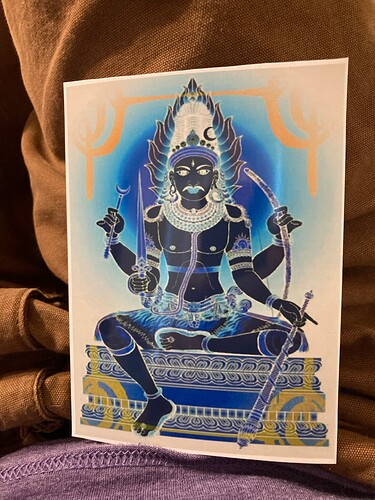Let’s have some description and context for this:
In Hindu mythology, Lord Virabhadra is considered to be a fierce avatar of Lord Shiva. He was created by Shiva in a moment of intense anger and sorrow, following the self-immolation of his first wife, Sati. Sati’s father, King Daksha, had organized a grand yagna (ritual sacrifice) and intentionally omitted inviting Shiva, disrespecting him. This angered and humiliated Sati, leading her to end her life by jumping into the yagna fire.
Upon hearing the news, Shiva was consumed by grief and anger. He pulled out a tuft of his hair and threw it to the ground, creating Virabhadra and his female counterpart, Bhadrakali. Virabhadra was a warrior avatar with a fearsome appearance, created for the sole purpose of destroying Daksha’s yagna and avenging the death of Sati.
Virabhadra stormed into Daksha’s assembly and, along with Bhadrakali and Shiva’s army of ghosts and ghouls, wreaked havoc. He beheaded Daksha but later replaced his head with that of a goat, upon Shiva’s instruction to restore him to life.
Lord Virabhadra is often depicted with multiple arms carrying various weapons, with a demeanor that embodies the wrath and power of Lord Shiva. His story is a symbol of Lord Shiva’s ability to create and destroy, and it serves as a lesson on the consequences of dishonoring divine entities.
Virabhadra is also honored and invoked in various forms of Hindu worship and practices, including in some branches of yoga, where several poses are named after him (Virabhadrasana I, II, and III). These poses aim to instill the qualities of a spiritual warrior into the practitioner.
Lord Virabhadra represents a range of qualities that are both fierce and righteous, embodying the wrath and power of Lord Shiva. Here are some of the core qualities he represents:
-
Unyielding Justice: Virabhadra was created with a specific mission—to avenge the insult and death of Sati. He symbolizes the unyielding pursuit of justice.
-
Fearlessness: The very appearance of Virabhadra is meant to strike fear into the hearts of evildoers. His fearless nature is a quality that many admire and aim to emulate.
-
Loyalty and Devotion: Virabhadra’s existence is due to his loyalty and devotion to Lord Shiva. He was created to exact revenge and did so without question, representing unwavering loyalty and devotion.
-
Focused Determination: Once Virabhadra was summoned, he had a singular focus—to disrupt Daksha’s yagna and bring him to justice. This speaks volumes about his determined nature.
-
Warrior Spirit: Virabhadra is often considered the epitome of the warrior spirit in Hindu mythology. He is relentless, fierce, and skilled in combat.
-
Manifestation of Anger and Grief: As an avatar created from Shiva’s emotions, he is a manifestation of righteous anger and sorrow, showing the power and intensity of these emotions when they are directed towards a noble cause.
-
Mercy and Compassion: After fulfilling his mission, Virabhadra shows mercy by restoring Daksha’s life on Shiva’s command, which adds a dimension of compassion to his otherwise fierce personality.
-
Supernatural Powers: Being an avatar of Shiva, he embodies supernatural capabilities, representing the limitless potential of divine power.
-
Complexity of Emotion: Virabhadra is not just a mindless entity of destruction; he also embodies the complexity of emotions that lead to actions which, while fierce, are rooted in a sense of righteousness and justice.
-
Balance of Creation and Destruction: Just as he was created to destroy, he also has the capacity to restore life, symbolizing the eternal cycle of creation and destruction in the universe.
These qualities make Virabhadra not just a symbol of divine wrath and power, but also a character of depth, embodying the complexities of emotion, justice, and the cosmic balance.
I’m starting to work with this NFT and I’m certainly feeling some of the traits, even tho it seems to be quite overwhelming for me.



 thank you
thank you
